TAX LAWS Assignment: Case Study on Taxation and Business Income
VerifiedAdded on 2021/06/15
|10
|2867
|65
Homework Assignment
AI Summary
This assignment delves into Australian taxation law, focusing on the determination of assessable income. It presents a case study involving Arthur Murray (NSW) Pty Ltd V FCT (1965) 114 CLR 314, analyzing the court's decision regarding advance payments for dance lessons and its implications for income recognition. The assignment further explores the application of the Income Tax Assessment Act 1997 (ITAA 1997), specifically sections 6-5 and 70-10, in determining assessable income and the choice between earning and receipt methods. It examines how these principles apply to a hypothetical business, RIP, providing funeral services, and the treatment of advance payments, forfeited payments, and trading stock. The solution considers the principles outlined in Taxation Ruling 98/1 and other relevant legal provisions to determine the tax implications for RIP. The assignment concludes with the analysis of a business's trading stock.

Running head: TAX LAWS
Tax Laws
Name of the student
Name of the university
Author note
Tax Laws
Name of the student
Name of the university
Author note
Paraphrase This Document
Need a fresh take? Get an instant paraphrase of this document with our AI Paraphraser

1
TAX LAWS
Part 1
Answer A
Case Facts
The case of Arthur Murray (NSW) Pty Ltd V FCT (1965) 114 CLR 314 is related to Australian
taxation law. The case is related to determination of the assessable income of the taxpayer. In
this case the company carried out a business if providing dancing courses for fees which varied
for hour to hour. The basic course of tuition which was present had 5, 15 or 30 hours of tuition
which could have been taken in a year by appointment. In addition there was course of 1200
hours which a student could have taken anytime during their life. Advance payment had to be
made by instalments or in lump sum and the company provided a rage of discount in relation to
instant payments. For instance the lifetime course of 1200 hours could have been reduced by
300 pounds where instant payment had been made. No right had been provided to the student to
claim a refund if the course could not be taken by them. However in reality the company at times
provided the refund. Once fees had been received it was immediately credited to an “Unearned
deposits - Untaught Lessons Account". When the lessons had been taught the fees had been
transferred periodically to "Earned Tuition Account". The income tax returns of the company
was made based on the notion that the money in the untaught lessons account were not a part of
its assessable income when they had been received but actually become an assessable income
when the lessons had been taught. On the other hand a claim was made by the commission that
such income was to be treated as an assessable income of the same year where they had been
received and there was no difference between the money in Unearned deposits - Untaught
Lessons Account and Earned Tuition Account.
TAX LAWS
Part 1
Answer A
Case Facts
The case of Arthur Murray (NSW) Pty Ltd V FCT (1965) 114 CLR 314 is related to Australian
taxation law. The case is related to determination of the assessable income of the taxpayer. In
this case the company carried out a business if providing dancing courses for fees which varied
for hour to hour. The basic course of tuition which was present had 5, 15 or 30 hours of tuition
which could have been taken in a year by appointment. In addition there was course of 1200
hours which a student could have taken anytime during their life. Advance payment had to be
made by instalments or in lump sum and the company provided a rage of discount in relation to
instant payments. For instance the lifetime course of 1200 hours could have been reduced by
300 pounds where instant payment had been made. No right had been provided to the student to
claim a refund if the course could not be taken by them. However in reality the company at times
provided the refund. Once fees had been received it was immediately credited to an “Unearned
deposits - Untaught Lessons Account". When the lessons had been taught the fees had been
transferred periodically to "Earned Tuition Account". The income tax returns of the company
was made based on the notion that the money in the untaught lessons account were not a part of
its assessable income when they had been received but actually become an assessable income
when the lessons had been taught. On the other hand a claim was made by the commission that
such income was to be treated as an assessable income of the same year where they had been
received and there was no difference between the money in Unearned deposits - Untaught
Lessons Account and Earned Tuition Account.

2
TAX LAWS
Issue Before the court
The issue in this case was to identify whether the view of commissioner or the view of the tax
payer was supported by legal provisions. If the view of the commissioner is to be taken than the
advance money received would be considered as an assessable income of the company and if the
view of the company is taken the advance money received would not be considered as the
assessable income of the company.
The decision of the court
In this case the court ruled in favour of the respondent company and dismissed the appeal made
by the minister. It had been stated by the court in this case that the money which was put into the
advanced account by the company and was received by the company as an advance fee for the
tuition would not be considered as an assessable income till the tuitions have actually been
provided by the company. The judges n this case relied on the case of Carden (1938) 63 CLR
108 where t was stated that where the issue is related to the assessment of an income the purpose
is to determine what profits have been received by the tax payer in a realizable form. The word
gain does not mean net profit in a business and it is also not synonymous with "receipts". This is
the amount which the tax payer has only been provided but also have “come home”. In this case
it was also stated by the court that the amount received by a business providing goods and
services for sale in advance is not to be considered as an assessable income of the business for
that year. Thus the court in this case also come to the conclusion that the advance which had
been received by the company would not be treated as an assessable income till the amount has
“come home” to the company.
1.
TAX LAWS
Issue Before the court
The issue in this case was to identify whether the view of commissioner or the view of the tax
payer was supported by legal provisions. If the view of the commissioner is to be taken than the
advance money received would be considered as an assessable income of the company and if the
view of the company is taken the advance money received would not be considered as the
assessable income of the company.
The decision of the court
In this case the court ruled in favour of the respondent company and dismissed the appeal made
by the minister. It had been stated by the court in this case that the money which was put into the
advanced account by the company and was received by the company as an advance fee for the
tuition would not be considered as an assessable income till the tuitions have actually been
provided by the company. The judges n this case relied on the case of Carden (1938) 63 CLR
108 where t was stated that where the issue is related to the assessment of an income the purpose
is to determine what profits have been received by the tax payer in a realizable form. The word
gain does not mean net profit in a business and it is also not synonymous with "receipts". This is
the amount which the tax payer has only been provided but also have “come home”. In this case
it was also stated by the court that the amount received by a business providing goods and
services for sale in advance is not to be considered as an assessable income of the business for
that year. Thus the court in this case also come to the conclusion that the advance which had
been received by the company would not be treated as an assessable income till the amount has
“come home” to the company.
1.
⊘ This is a preview!⊘
Do you want full access?
Subscribe today to unlock all pages.

Trusted by 1+ million students worldwide
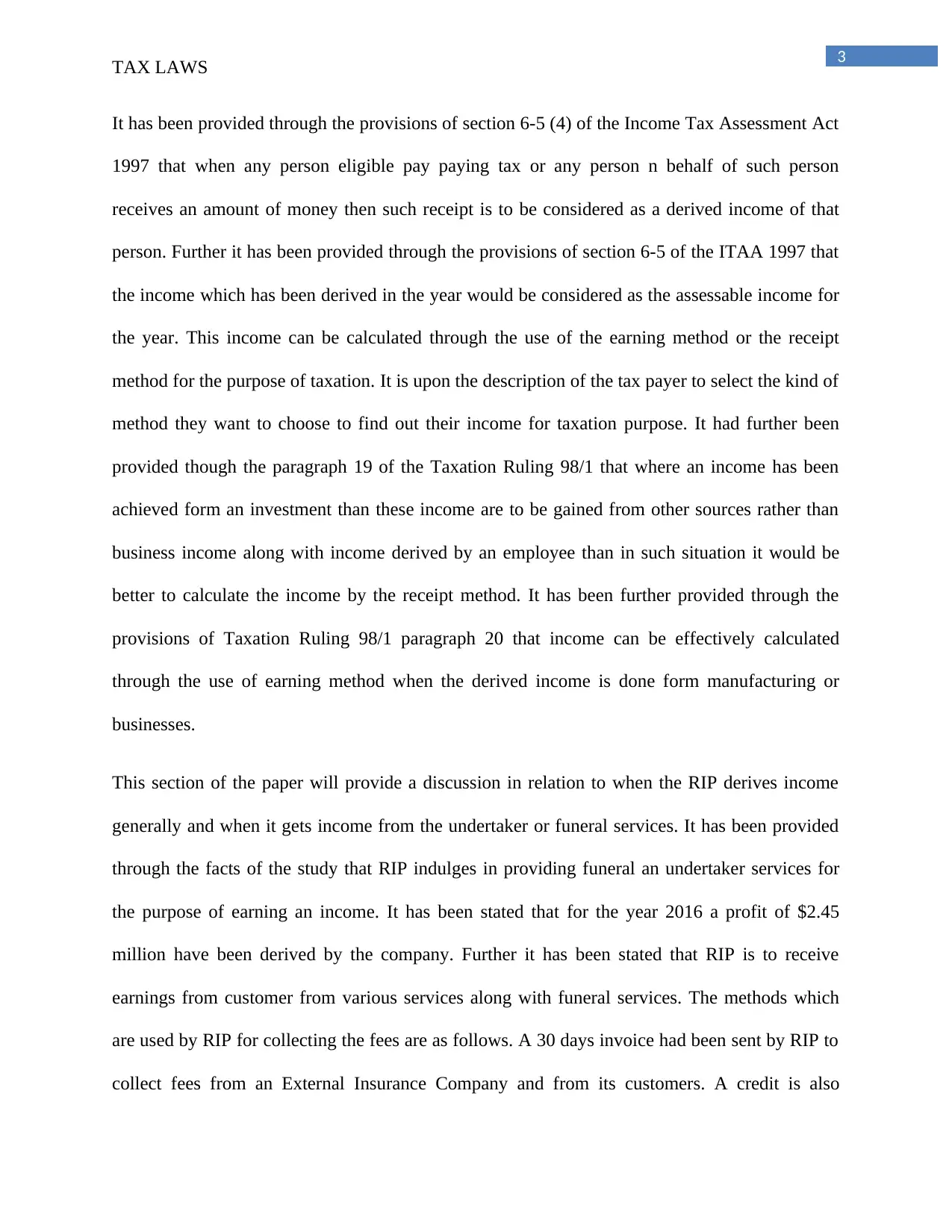
3
TAX LAWS
It has been provided through the provisions of section 6-5 (4) of the Income Tax Assessment Act
1997 that when any person eligible pay paying tax or any person n behalf of such person
receives an amount of money then such receipt is to be considered as a derived income of that
person. Further it has been provided through the provisions of section 6-5 of the ITAA 1997 that
the income which has been derived in the year would be considered as the assessable income for
the year. This income can be calculated through the use of the earning method or the receipt
method for the purpose of taxation. It is upon the description of the tax payer to select the kind of
method they want to choose to find out their income for taxation purpose. It had further been
provided though the paragraph 19 of the Taxation Ruling 98/1 that where an income has been
achieved form an investment than these income are to be gained from other sources rather than
business income along with income derived by an employee than in such situation it would be
better to calculate the income by the receipt method. It has been further provided through the
provisions of Taxation Ruling 98/1 paragraph 20 that income can be effectively calculated
through the use of earning method when the derived income is done form manufacturing or
businesses.
This section of the paper will provide a discussion in relation to when the RIP derives income
generally and when it gets income from the undertaker or funeral services. It has been provided
through the facts of the study that RIP indulges in providing funeral an undertaker services for
the purpose of earning an income. It has been stated that for the year 2016 a profit of $2.45
million have been derived by the company. Further it has been stated that RIP is to receive
earnings from customer from various services along with funeral services. The methods which
are used by RIP for collecting the fees are as follows. A 30 days invoice had been sent by RIP to
collect fees from an External Insurance Company and from its customers. A credit is also
TAX LAWS
It has been provided through the provisions of section 6-5 (4) of the Income Tax Assessment Act
1997 that when any person eligible pay paying tax or any person n behalf of such person
receives an amount of money then such receipt is to be considered as a derived income of that
person. Further it has been provided through the provisions of section 6-5 of the ITAA 1997 that
the income which has been derived in the year would be considered as the assessable income for
the year. This income can be calculated through the use of the earning method or the receipt
method for the purpose of taxation. It is upon the description of the tax payer to select the kind of
method they want to choose to find out their income for taxation purpose. It had further been
provided though the paragraph 19 of the Taxation Ruling 98/1 that where an income has been
achieved form an investment than these income are to be gained from other sources rather than
business income along with income derived by an employee than in such situation it would be
better to calculate the income by the receipt method. It has been further provided through the
provisions of Taxation Ruling 98/1 paragraph 20 that income can be effectively calculated
through the use of earning method when the derived income is done form manufacturing or
businesses.
This section of the paper will provide a discussion in relation to when the RIP derives income
generally and when it gets income from the undertaker or funeral services. It has been provided
through the facts of the study that RIP indulges in providing funeral an undertaker services for
the purpose of earning an income. It has been stated that for the year 2016 a profit of $2.45
million have been derived by the company. Further it has been stated that RIP is to receive
earnings from customer from various services along with funeral services. The methods which
are used by RIP for collecting the fees are as follows. A 30 days invoice had been sent by RIP to
collect fees from an External Insurance Company and from its customers. A credit is also
Paraphrase This Document
Need a fresh take? Get an instant paraphrase of this document with our AI Paraphraser
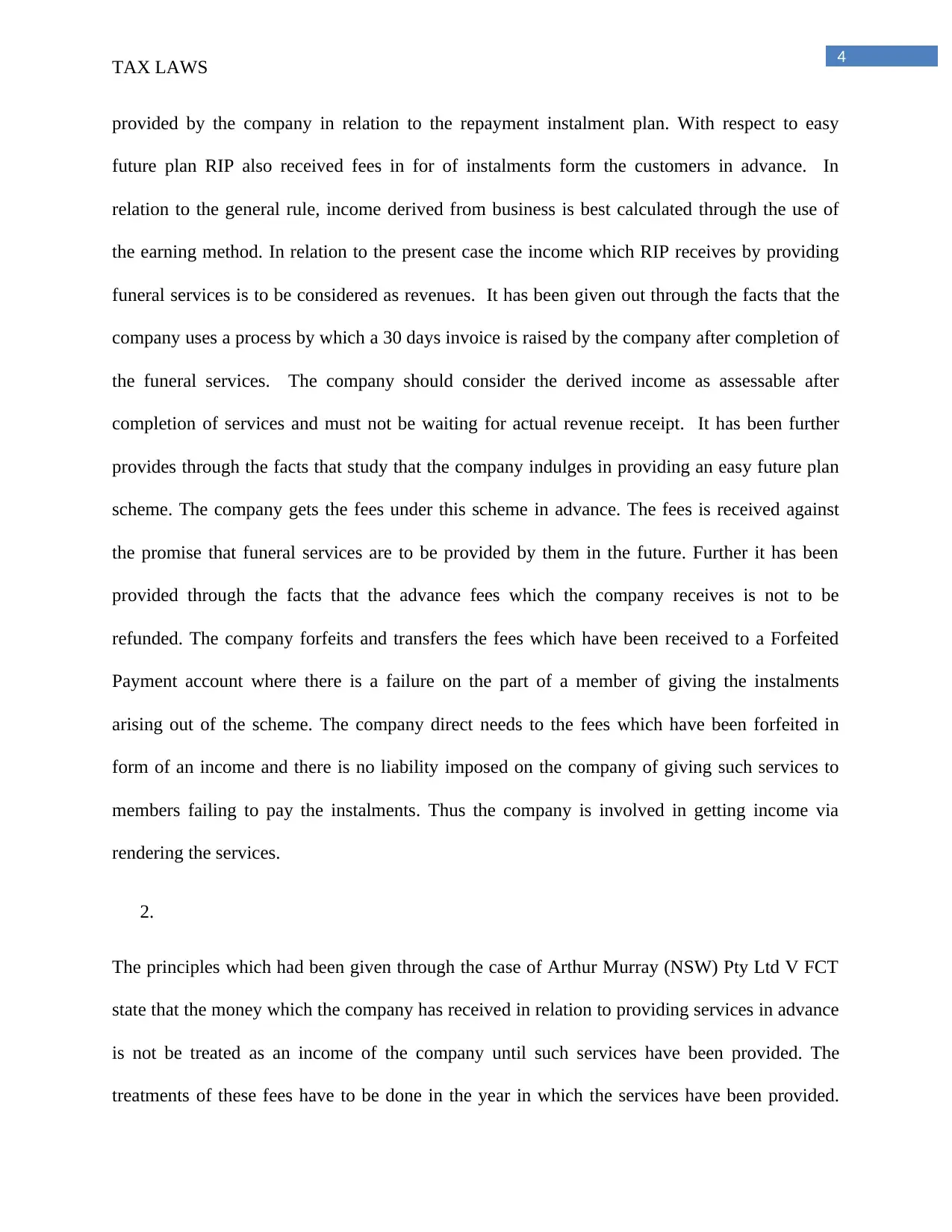
4
TAX LAWS
provided by the company in relation to the repayment instalment plan. With respect to easy
future plan RIP also received fees in for of instalments form the customers in advance. In
relation to the general rule, income derived from business is best calculated through the use of
the earning method. In relation to the present case the income which RIP receives by providing
funeral services is to be considered as revenues. It has been given out through the facts that the
company uses a process by which a 30 days invoice is raised by the company after completion of
the funeral services. The company should consider the derived income as assessable after
completion of services and must not be waiting for actual revenue receipt. It has been further
provides through the facts that study that the company indulges in providing an easy future plan
scheme. The company gets the fees under this scheme in advance. The fees is received against
the promise that funeral services are to be provided by them in the future. Further it has been
provided through the facts that the advance fees which the company receives is not to be
refunded. The company forfeits and transfers the fees which have been received to a Forfeited
Payment account where there is a failure on the part of a member of giving the instalments
arising out of the scheme. The company direct needs to the fees which have been forfeited in
form of an income and there is no liability imposed on the company of giving such services to
members failing to pay the instalments. Thus the company is involved in getting income via
rendering the services.
2.
The principles which had been given through the case of Arthur Murray (NSW) Pty Ltd V FCT
state that the money which the company has received in relation to providing services in advance
is not be treated as an income of the company until such services have been provided. The
treatments of these fees have to be done in the year in which the services have been provided.
TAX LAWS
provided by the company in relation to the repayment instalment plan. With respect to easy
future plan RIP also received fees in for of instalments form the customers in advance. In
relation to the general rule, income derived from business is best calculated through the use of
the earning method. In relation to the present case the income which RIP receives by providing
funeral services is to be considered as revenues. It has been given out through the facts that the
company uses a process by which a 30 days invoice is raised by the company after completion of
the funeral services. The company should consider the derived income as assessable after
completion of services and must not be waiting for actual revenue receipt. It has been further
provides through the facts that study that the company indulges in providing an easy future plan
scheme. The company gets the fees under this scheme in advance. The fees is received against
the promise that funeral services are to be provided by them in the future. Further it has been
provided through the facts that the advance fees which the company receives is not to be
refunded. The company forfeits and transfers the fees which have been received to a Forfeited
Payment account where there is a failure on the part of a member of giving the instalments
arising out of the scheme. The company direct needs to the fees which have been forfeited in
form of an income and there is no liability imposed on the company of giving such services to
members failing to pay the instalments. Thus the company is involved in getting income via
rendering the services.
2.
The principles which had been given through the case of Arthur Murray (NSW) Pty Ltd V FCT
state that the money which the company has received in relation to providing services in advance
is not be treated as an income of the company until such services have been provided. The
treatments of these fees have to be done in the year in which the services have been provided.
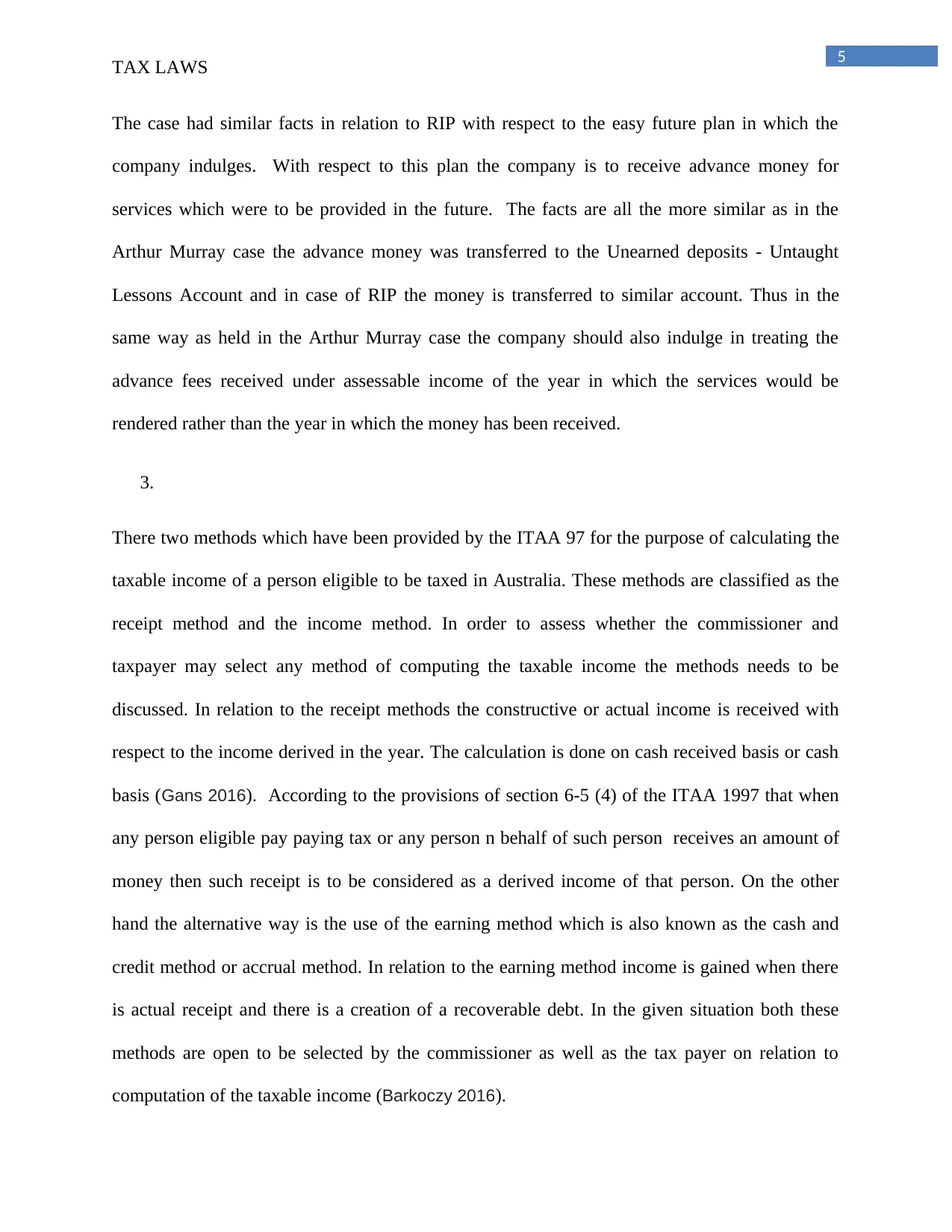
5
TAX LAWS
The case had similar facts in relation to RIP with respect to the easy future plan in which the
company indulges. With respect to this plan the company is to receive advance money for
services which were to be provided in the future. The facts are all the more similar as in the
Arthur Murray case the advance money was transferred to the Unearned deposits - Untaught
Lessons Account and in case of RIP the money is transferred to similar account. Thus in the
same way as held in the Arthur Murray case the company should also indulge in treating the
advance fees received under assessable income of the year in which the services would be
rendered rather than the year in which the money has been received.
3.
There two methods which have been provided by the ITAA 97 for the purpose of calculating the
taxable income of a person eligible to be taxed in Australia. These methods are classified as the
receipt method and the income method. In order to assess whether the commissioner and
taxpayer may select any method of computing the taxable income the methods needs to be
discussed. In relation to the receipt methods the constructive or actual income is received with
respect to the income derived in the year. The calculation is done on cash received basis or cash
basis (Gans 2016). According to the provisions of section 6-5 (4) of the ITAA 1997 that when
any person eligible pay paying tax or any person n behalf of such person receives an amount of
money then such receipt is to be considered as a derived income of that person. On the other
hand the alternative way is the use of the earning method which is also known as the cash and
credit method or accrual method. In relation to the earning method income is gained when there
is actual receipt and there is a creation of a recoverable debt. In the given situation both these
methods are open to be selected by the commissioner as well as the tax payer on relation to
computation of the taxable income (Barkoczy 2016).
TAX LAWS
The case had similar facts in relation to RIP with respect to the easy future plan in which the
company indulges. With respect to this plan the company is to receive advance money for
services which were to be provided in the future. The facts are all the more similar as in the
Arthur Murray case the advance money was transferred to the Unearned deposits - Untaught
Lessons Account and in case of RIP the money is transferred to similar account. Thus in the
same way as held in the Arthur Murray case the company should also indulge in treating the
advance fees received under assessable income of the year in which the services would be
rendered rather than the year in which the money has been received.
3.
There two methods which have been provided by the ITAA 97 for the purpose of calculating the
taxable income of a person eligible to be taxed in Australia. These methods are classified as the
receipt method and the income method. In order to assess whether the commissioner and
taxpayer may select any method of computing the taxable income the methods needs to be
discussed. In relation to the receipt methods the constructive or actual income is received with
respect to the income derived in the year. The calculation is done on cash received basis or cash
basis (Gans 2016). According to the provisions of section 6-5 (4) of the ITAA 1997 that when
any person eligible pay paying tax or any person n behalf of such person receives an amount of
money then such receipt is to be considered as a derived income of that person. On the other
hand the alternative way is the use of the earning method which is also known as the cash and
credit method or accrual method. In relation to the earning method income is gained when there
is actual receipt and there is a creation of a recoverable debt. In the given situation both these
methods are open to be selected by the commissioner as well as the tax payer on relation to
computation of the taxable income (Barkoczy 2016).
⊘ This is a preview!⊘
Do you want full access?
Subscribe today to unlock all pages.

Trusted by 1+ million students worldwide
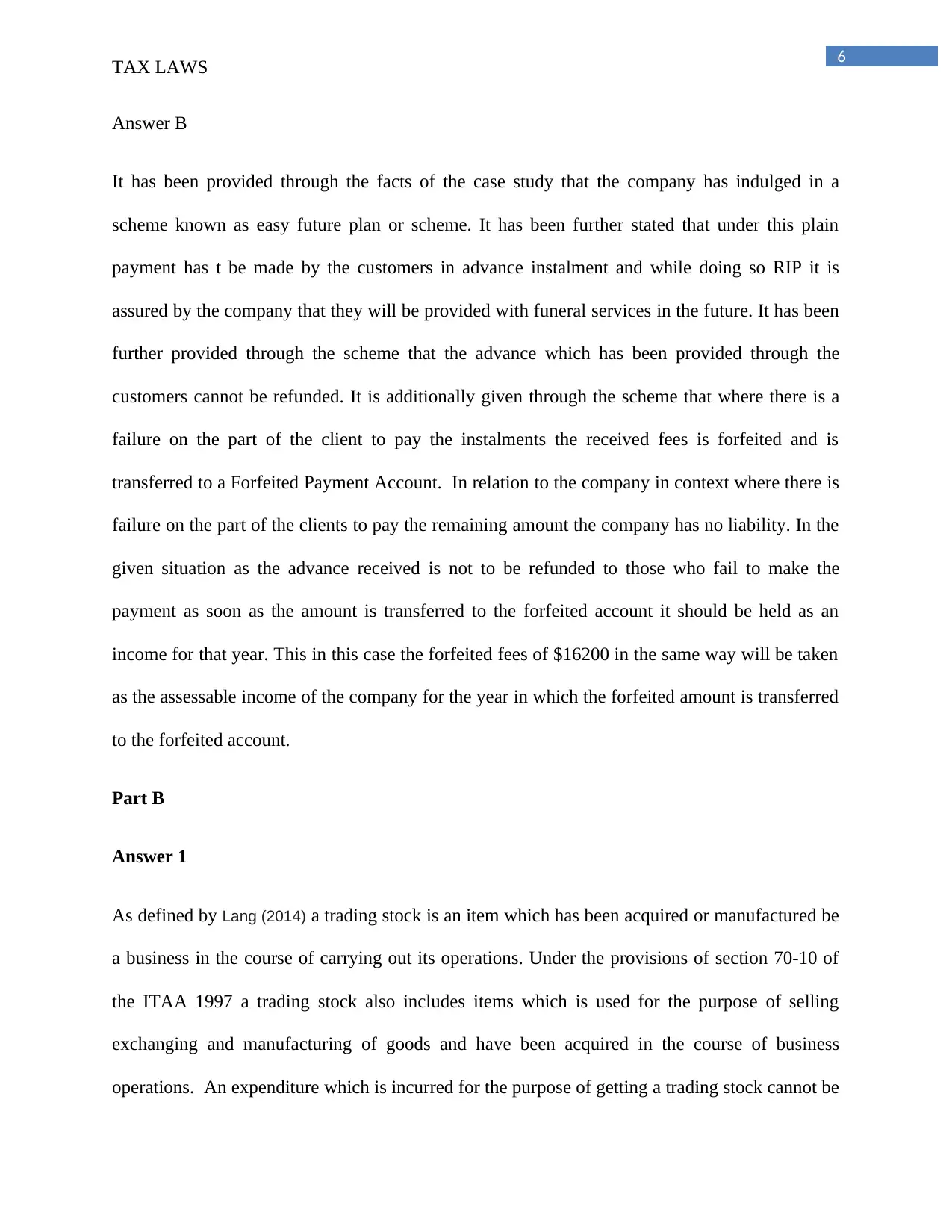
6
TAX LAWS
Answer B
It has been provided through the facts of the case study that the company has indulged in a
scheme known as easy future plan or scheme. It has been further stated that under this plain
payment has t be made by the customers in advance instalment and while doing so RIP it is
assured by the company that they will be provided with funeral services in the future. It has been
further provided through the scheme that the advance which has been provided through the
customers cannot be refunded. It is additionally given through the scheme that where there is a
failure on the part of the client to pay the instalments the received fees is forfeited and is
transferred to a Forfeited Payment Account. In relation to the company in context where there is
failure on the part of the clients to pay the remaining amount the company has no liability. In the
given situation as the advance received is not to be refunded to those who fail to make the
payment as soon as the amount is transferred to the forfeited account it should be held as an
income for that year. This in this case the forfeited fees of $16200 in the same way will be taken
as the assessable income of the company for the year in which the forfeited amount is transferred
to the forfeited account.
Part B
Answer 1
As defined by Lang (2014) a trading stock is an item which has been acquired or manufactured be
a business in the course of carrying out its operations. Under the provisions of section 70-10 of
the ITAA 1997 a trading stock also includes items which is used for the purpose of selling
exchanging and manufacturing of goods and have been acquired in the course of business
operations. An expenditure which is incurred for the purpose of getting a trading stock cannot be
TAX LAWS
Answer B
It has been provided through the facts of the case study that the company has indulged in a
scheme known as easy future plan or scheme. It has been further stated that under this plain
payment has t be made by the customers in advance instalment and while doing so RIP it is
assured by the company that they will be provided with funeral services in the future. It has been
further provided through the scheme that the advance which has been provided through the
customers cannot be refunded. It is additionally given through the scheme that where there is a
failure on the part of the client to pay the instalments the received fees is forfeited and is
transferred to a Forfeited Payment Account. In relation to the company in context where there is
failure on the part of the clients to pay the remaining amount the company has no liability. In the
given situation as the advance received is not to be refunded to those who fail to make the
payment as soon as the amount is transferred to the forfeited account it should be held as an
income for that year. This in this case the forfeited fees of $16200 in the same way will be taken
as the assessable income of the company for the year in which the forfeited amount is transferred
to the forfeited account.
Part B
Answer 1
As defined by Lang (2014) a trading stock is an item which has been acquired or manufactured be
a business in the course of carrying out its operations. Under the provisions of section 70-10 of
the ITAA 1997 a trading stock also includes items which is used for the purpose of selling
exchanging and manufacturing of goods and have been acquired in the course of business
operations. An expenditure which is incurred for the purpose of getting a trading stock cannot be
Paraphrase This Document
Need a fresh take? Get an instant paraphrase of this document with our AI Paraphraser
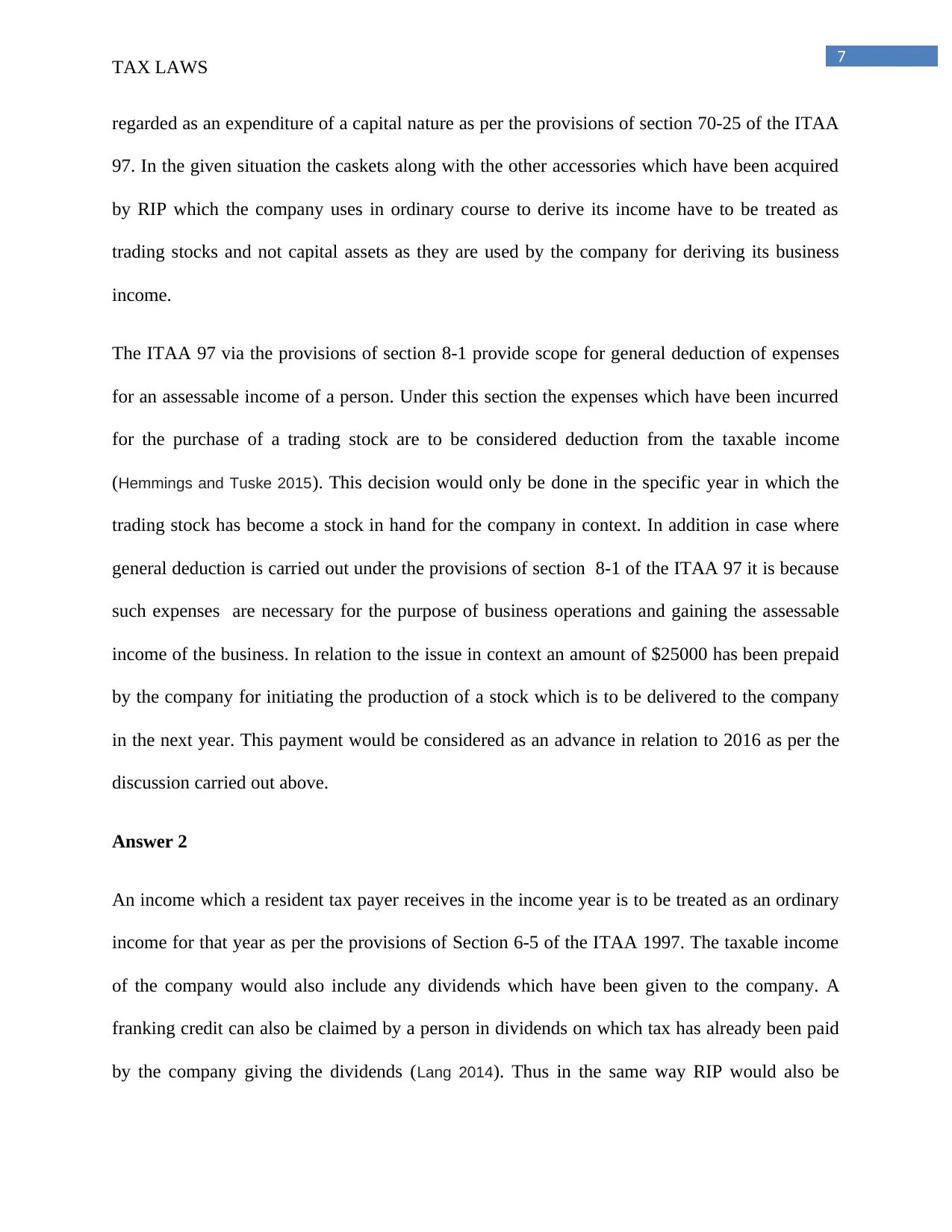
7
TAX LAWS
regarded as an expenditure of a capital nature as per the provisions of section 70-25 of the ITAA
97. In the given situation the caskets along with the other accessories which have been acquired
by RIP which the company uses in ordinary course to derive its income have to be treated as
trading stocks and not capital assets as they are used by the company for deriving its business
income.
The ITAA 97 via the provisions of section 8-1 provide scope for general deduction of expenses
for an assessable income of a person. Under this section the expenses which have been incurred
for the purchase of a trading stock are to be considered deduction from the taxable income
(Hemmings and Tuske 2015). This decision would only be done in the specific year in which the
trading stock has become a stock in hand for the company in context. In addition in case where
general deduction is carried out under the provisions of section 8-1 of the ITAA 97 it is because
such expenses are necessary for the purpose of business operations and gaining the assessable
income of the business. In relation to the issue in context an amount of $25000 has been prepaid
by the company for initiating the production of a stock which is to be delivered to the company
in the next year. This payment would be considered as an advance in relation to 2016 as per the
discussion carried out above.
Answer 2
An income which a resident tax payer receives in the income year is to be treated as an ordinary
income for that year as per the provisions of Section 6-5 of the ITAA 1997. The taxable income
of the company would also include any dividends which have been given to the company. A
franking credit can also be claimed by a person in dividends on which tax has already been paid
by the company giving the dividends (Lang 2014). Thus in the same way RIP would also be
TAX LAWS
regarded as an expenditure of a capital nature as per the provisions of section 70-25 of the ITAA
97. In the given situation the caskets along with the other accessories which have been acquired
by RIP which the company uses in ordinary course to derive its income have to be treated as
trading stocks and not capital assets as they are used by the company for deriving its business
income.
The ITAA 97 via the provisions of section 8-1 provide scope for general deduction of expenses
for an assessable income of a person. Under this section the expenses which have been incurred
for the purchase of a trading stock are to be considered deduction from the taxable income
(Hemmings and Tuske 2015). This decision would only be done in the specific year in which the
trading stock has become a stock in hand for the company in context. In addition in case where
general deduction is carried out under the provisions of section 8-1 of the ITAA 97 it is because
such expenses are necessary for the purpose of business operations and gaining the assessable
income of the business. In relation to the issue in context an amount of $25000 has been prepaid
by the company for initiating the production of a stock which is to be delivered to the company
in the next year. This payment would be considered as an advance in relation to 2016 as per the
discussion carried out above.
Answer 2
An income which a resident tax payer receives in the income year is to be treated as an ordinary
income for that year as per the provisions of Section 6-5 of the ITAA 1997. The taxable income
of the company would also include any dividends which have been given to the company. A
franking credit can also be claimed by a person in dividends on which tax has already been paid
by the company giving the dividends (Lang 2014). Thus in the same way RIP would also be
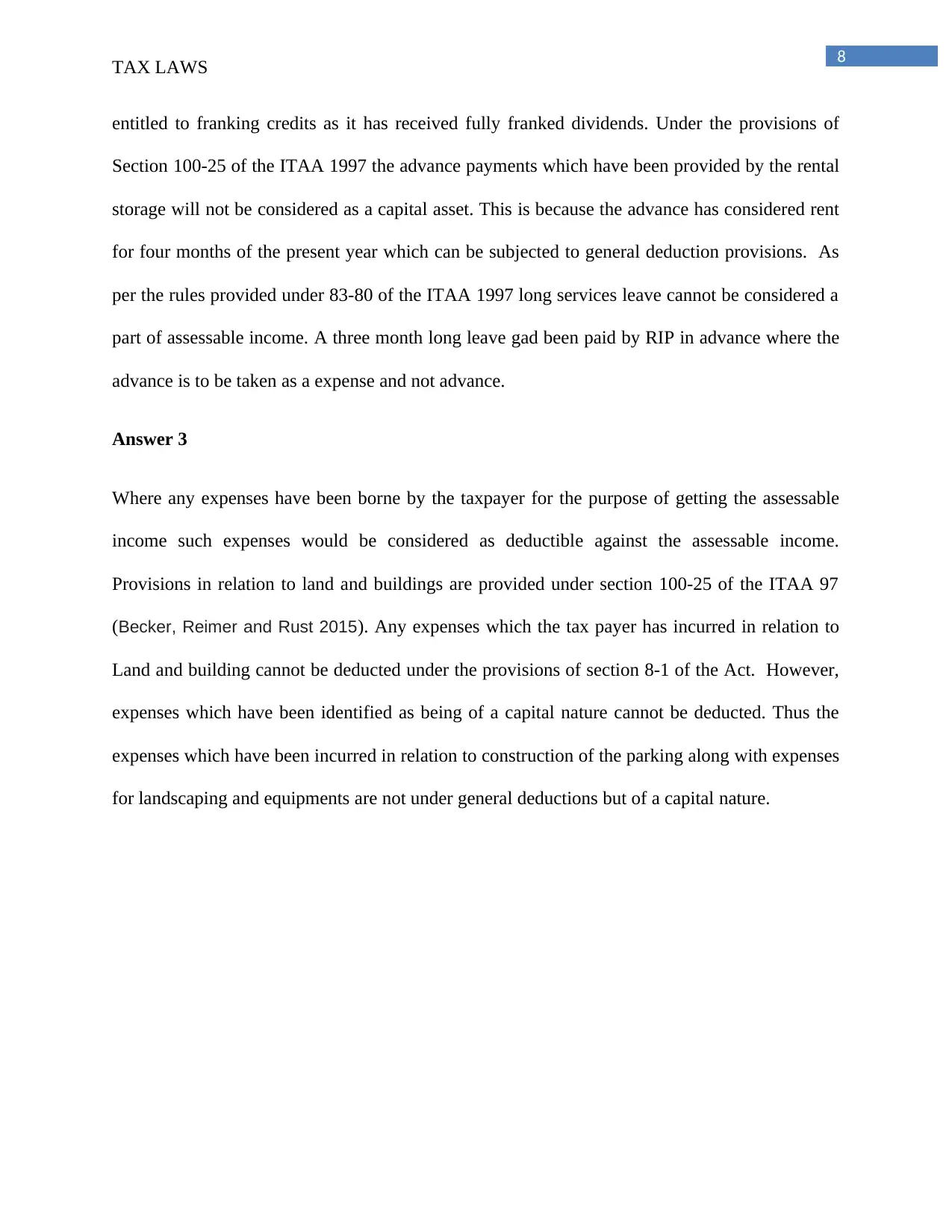
8
TAX LAWS
entitled to franking credits as it has received fully franked dividends. Under the provisions of
Section 100-25 of the ITAA 1997 the advance payments which have been provided by the rental
storage will not be considered as a capital asset. This is because the advance has considered rent
for four months of the present year which can be subjected to general deduction provisions. As
per the rules provided under 83-80 of the ITAA 1997 long services leave cannot be considered a
part of assessable income. A three month long leave gad been paid by RIP in advance where the
advance is to be taken as a expense and not advance.
Answer 3
Where any expenses have been borne by the taxpayer for the purpose of getting the assessable
income such expenses would be considered as deductible against the assessable income.
Provisions in relation to land and buildings are provided under section 100-25 of the ITAA 97
(Becker, Reimer and Rust 2015). Any expenses which the tax payer has incurred in relation to
Land and building cannot be deducted under the provisions of section 8-1 of the Act. However,
expenses which have been identified as being of a capital nature cannot be deducted. Thus the
expenses which have been incurred in relation to construction of the parking along with expenses
for landscaping and equipments are not under general deductions but of a capital nature.
TAX LAWS
entitled to franking credits as it has received fully franked dividends. Under the provisions of
Section 100-25 of the ITAA 1997 the advance payments which have been provided by the rental
storage will not be considered as a capital asset. This is because the advance has considered rent
for four months of the present year which can be subjected to general deduction provisions. As
per the rules provided under 83-80 of the ITAA 1997 long services leave cannot be considered a
part of assessable income. A three month long leave gad been paid by RIP in advance where the
advance is to be taken as a expense and not advance.
Answer 3
Where any expenses have been borne by the taxpayer for the purpose of getting the assessable
income such expenses would be considered as deductible against the assessable income.
Provisions in relation to land and buildings are provided under section 100-25 of the ITAA 97
(Becker, Reimer and Rust 2015). Any expenses which the tax payer has incurred in relation to
Land and building cannot be deducted under the provisions of section 8-1 of the Act. However,
expenses which have been identified as being of a capital nature cannot be deducted. Thus the
expenses which have been incurred in relation to construction of the parking along with expenses
for landscaping and equipments are not under general deductions but of a capital nature.
⊘ This is a preview!⊘
Do you want full access?
Subscribe today to unlock all pages.

Trusted by 1+ million students worldwide
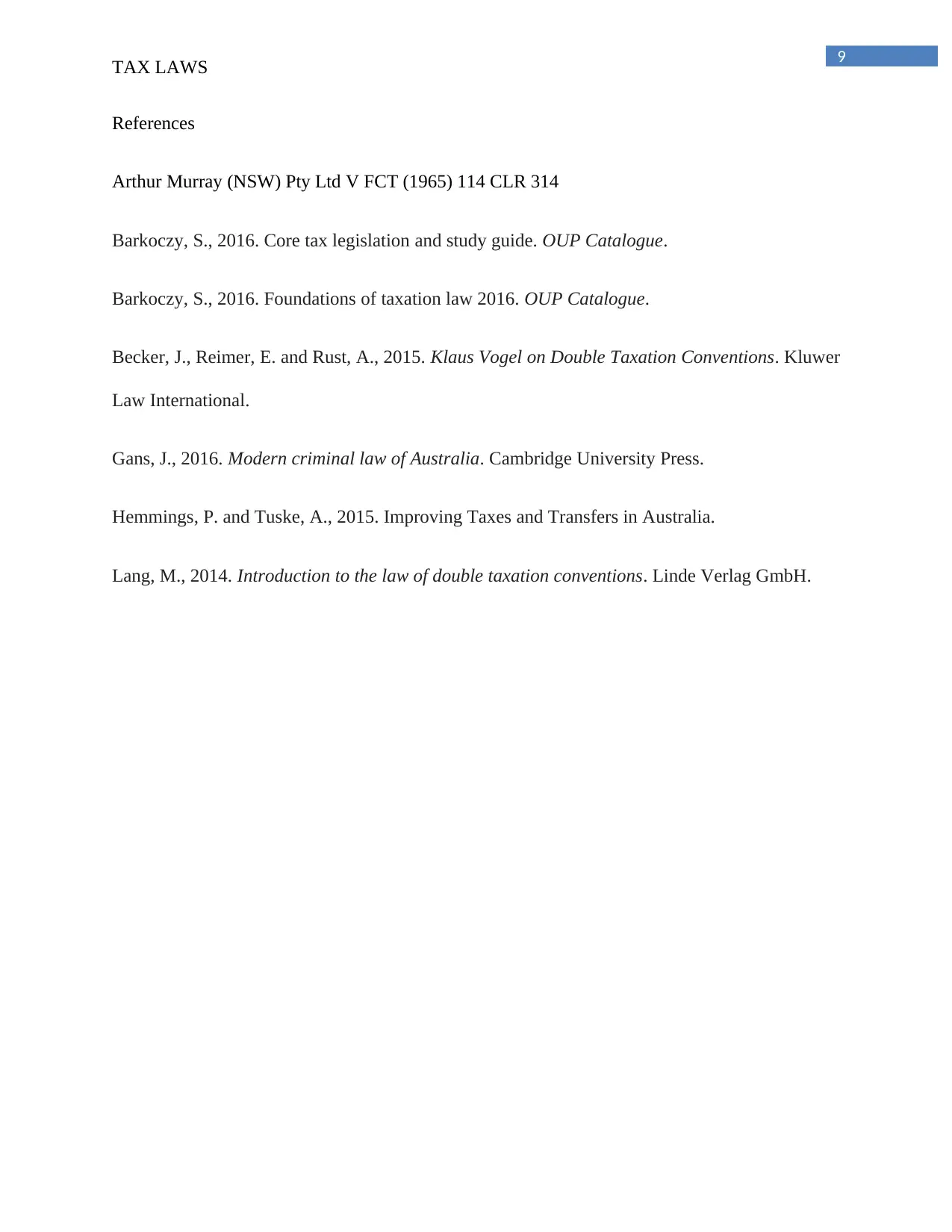
9
TAX LAWS
References
Arthur Murray (NSW) Pty Ltd V FCT (1965) 114 CLR 314
Barkoczy, S., 2016. Core tax legislation and study guide. OUP Catalogue.
Barkoczy, S., 2016. Foundations of taxation law 2016. OUP Catalogue.
Becker, J., Reimer, E. and Rust, A., 2015. Klaus Vogel on Double Taxation Conventions. Kluwer
Law International.
Gans, J., 2016. Modern criminal law of Australia. Cambridge University Press.
Hemmings, P. and Tuske, A., 2015. Improving Taxes and Transfers in Australia.
Lang, M., 2014. Introduction to the law of double taxation conventions. Linde Verlag GmbH.
TAX LAWS
References
Arthur Murray (NSW) Pty Ltd V FCT (1965) 114 CLR 314
Barkoczy, S., 2016. Core tax legislation and study guide. OUP Catalogue.
Barkoczy, S., 2016. Foundations of taxation law 2016. OUP Catalogue.
Becker, J., Reimer, E. and Rust, A., 2015. Klaus Vogel on Double Taxation Conventions. Kluwer
Law International.
Gans, J., 2016. Modern criminal law of Australia. Cambridge University Press.
Hemmings, P. and Tuske, A., 2015. Improving Taxes and Transfers in Australia.
Lang, M., 2014. Introduction to the law of double taxation conventions. Linde Verlag GmbH.
1 out of 10
Related Documents
Your All-in-One AI-Powered Toolkit for Academic Success.
+13062052269
info@desklib.com
Available 24*7 on WhatsApp / Email
![[object Object]](/_next/static/media/star-bottom.7253800d.svg)
Unlock your academic potential
Copyright © 2020–2025 A2Z Services. All Rights Reserved. Developed and managed by ZUCOL.





